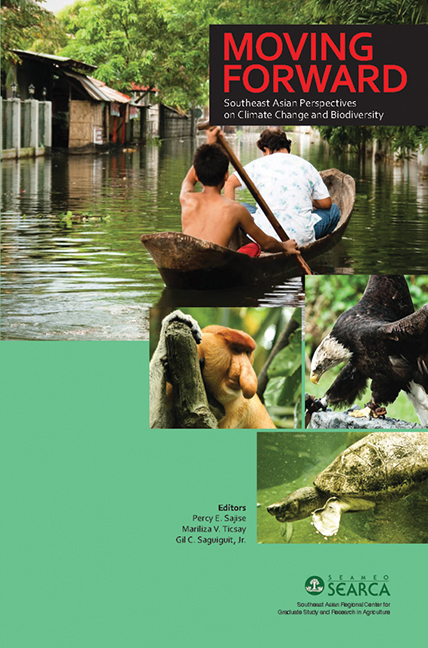Book contents
- Frontmatter
- Contents
- Tables
- Figures
- Foreword
- Preface
- Contributors
- Acronyms
- INTRODUCTION
- REGIONAL PERSPECTIVES AND CROSS-CUTTING ISSUES
- COUNTRY PERSPECTIVES
- 5 Animal Genetic Resource Conservation and Climate Change in Cambodia: Reducing Livestock to Decrease GHG Emission?
- 6 Malaysia's Current Policy and Research Initiatives Toward Climate Change: Impacts to Biodiversity
- 7 Anticipated Impacts of Climate Change on Marine Biodiversity: Using Field Situations that Simulate Climate Change in Singapore
- 8 Climate Change and Biodiversity in the Philippines: Potential Impacts and Adaptation Strategies
- 9 Research Initiatives on Climate Change Impacts and Adaptation in Thailand
- 10 The Role of Biodiversity in Climate Change Mitigation in Vietnam: The Red River Estuary - Ba Lat Case Study
- 11 Implications of the Dutch-Philippines Biodiversity Research on the Impacts, Vulnerability, and Adaptation to Climate Change: The Coastal Ecosystem
- CHALLENGES AND FUTURE ACTIONS
- Index
6 - Malaysia's Current Policy and Research Initiatives Toward Climate Change: Impacts to Biodiversity
from COUNTRY PERSPECTIVES
Published online by Cambridge University Press: 21 October 2015
- Frontmatter
- Contents
- Tables
- Figures
- Foreword
- Preface
- Contributors
- Acronyms
- INTRODUCTION
- REGIONAL PERSPECTIVES AND CROSS-CUTTING ISSUES
- COUNTRY PERSPECTIVES
- 5 Animal Genetic Resource Conservation and Climate Change in Cambodia: Reducing Livestock to Decrease GHG Emission?
- 6 Malaysia's Current Policy and Research Initiatives Toward Climate Change: Impacts to Biodiversity
- 7 Anticipated Impacts of Climate Change on Marine Biodiversity: Using Field Situations that Simulate Climate Change in Singapore
- 8 Climate Change and Biodiversity in the Philippines: Potential Impacts and Adaptation Strategies
- 9 Research Initiatives on Climate Change Impacts and Adaptation in Thailand
- 10 The Role of Biodiversity in Climate Change Mitigation in Vietnam: The Red River Estuary - Ba Lat Case Study
- 11 Implications of the Dutch-Philippines Biodiversity Research on the Impacts, Vulnerability, and Adaptation to Climate Change: The Coastal Ecosystem
- CHALLENGES AND FUTURE ACTIONS
- Index
Summary
Malaysia is an equatorial country lying between 1.0°-7°N latitude and 99.5°- 120°E longitude. It is a coastal nation, rich in biodiversity and natural resources.
Malaysia covers an area of 329,996 km2 and is divided into two land masses separated by the South China Sea. There is Peninsular Malaysia in the west, with an area of 131,927 km2. It is composed of 11 states, the Federal Territory of Kuala Lumpur (Legislative Capital), and the Federal Territory of Putrajaya (Administrative Capital) (Figure 6.1 and Table 6.1).
Peninsular Malaysia is bordered in the north by Thailand, and in the south by Singapore. In the east, in the island of Borneo, are the states of Sabah and Sarawak. These states occupy an aggregated area of 198,069 km2. The Federal Territory of Labuan, is located in the northwest coast of Borneo island. Between Sabah and Sarawak is the nation of Brunei Darussalam. Indonesia borders the south of Sabah and the rest of Sarawak.
The nation is endowed with tracts of rich and highly diverse natural tropical forests that cover about 60 per cent of the country's total area or about 198,000 km2. The dominant habitats include lowland and hill dipterocarp forests, peat swamps, and mangroves. Over 90 per cent of the country's terrestrial biological species occur in natural forests. These valuable renewable assets have helped sustain the nation's rapid growing economy and development. About 20 per cent of the country's land area is categorized as agriculture, which includes plantations of oil palm, cocoa, and rubber tree, among others. The remaining 20 per cent is designated for development.
The country's current population is estimated at 25 M – 80 per cent of which have settled in Peninsular Malaysia, while the remaining 20 per cent have dispersed in Sabah and Sarawak.
MALAYSIA'S FORESTRY SECTOR
The forestry sector continues to play a significant role in the socioeconomic development of Malaysia. Export earnings contribute at least US$4.4 B annually. Logging in Malaysia has gone far beyond the level of sustainability.
- Type
- Chapter
- Information
- Moving ForwardSoutheast Asian Perspectives on Climate Change and Biodiversity, pp. 101 - 130Publisher: ISEAS–Yusof Ishak InstitutePrint publication year: 2010

